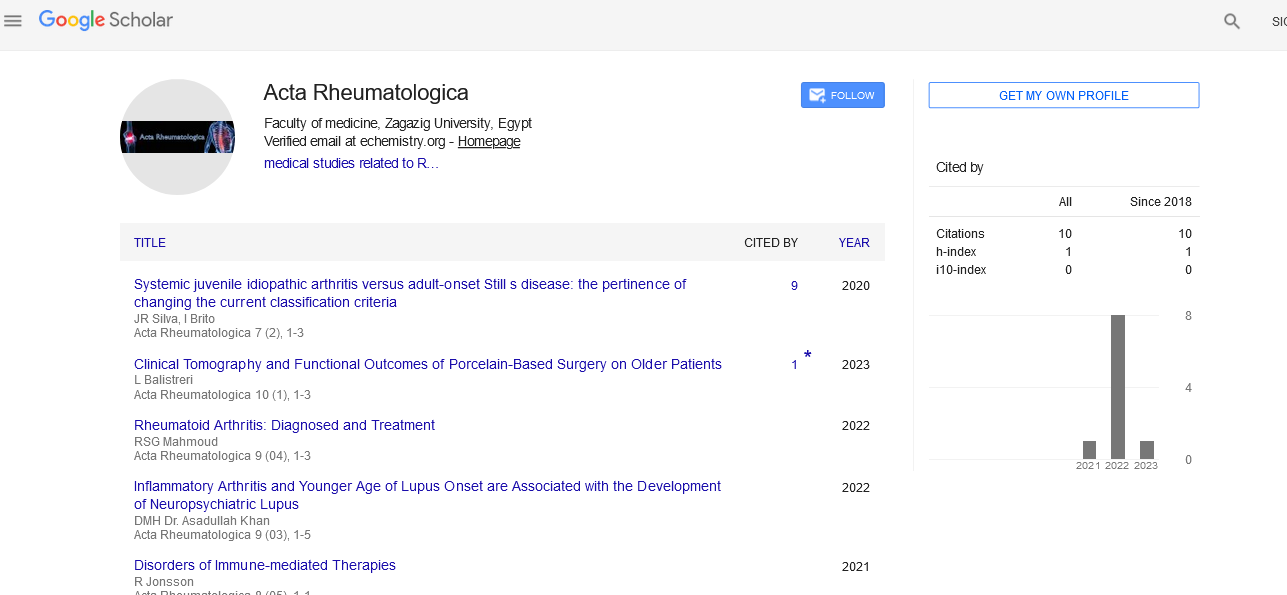Perspective - (2025) Volume 12, Issue 1
Physical Therapy: Restoring Mobility and Enhancing Well-Being
Richard Whitley*
Department of Physical Therapy, University of Miyazaki, Miyazaki City, Japan
*Correspondence:
Richard Whitley, Department of Physical Therapy, University of Miyazaki, Miyazaki City,
Japan,
Email:
Received: 20-Feb-2025, Manuscript No. IPAR-25-15555;
Editor assigned: 24-Feb-2025, Pre QC No. IPAR-25-15555 (PQ);
Reviewed: 11-Mar-2025, QC No. IPAR-25-15555;
Revised: 19-Mar-2025, Manuscript No. IPAR-25-15555 (R);
Published:
27-Mar-2025
Introduction
Physical Therapy (PT) is a healthcare profession dedicated to
restoring movement, alleviating pain, and improving overall
function in individuals affected by injury, illness, or disability. It
combines evidence-based techniques, patient education, and
therapeutic exercises to help individuals regain strength and
mobility. As a crucial aspect of rehabilitation, physical therapy
plays an essential role in improving quality of life and preventing
long-term complications.
Description
History and evolution of physical therapy
Physical therapy has its roots in ancient civilizations, where
massage and movement techniques were used to treat
musculoskeletal disorders. Modern physical therapy emerged
during World War I and II to rehabilitate injured soldiers. Over
the years, advancements in medical science have led to
specialized techniques, evidence-based practices, and the
integration of technology to enhance patient outcomes.
Goals of physical therapy
The primary goals of physical therapy include:
Pain management: Reducing pain through manual therapy,
exercise, and modalities such as heat or ultrasound.
Restoring function: Improving movement, strength, and
coordination for daily activities.
Injury prevention: Enhancing muscle and joint stability to
reduce the risk of future injuries.
Rehabilitation: Assisting in recovery from surgeries, strokes,
or chronic conditions.
Enhancing mobility: Improving flexibility and movement
efficiency for better performance in sports and daily life.
Types of physical therapy
Physical therapy is a diverse field encompassing several
specialized areas tailored to different patient needs:
Orthopedic physical therapy: Focused on musculoskeletal
injuries, orthopedic physical therapy treats conditions like
fractures, sprains, back pain, arthritis, and post-surgical recovery.
Techniques include:
• Strengthening exercises.
• Joint mobilization.
• Manual therapy.
• Postural correction.
Neurological physical therapy: Designed for patients with
neurological disorders such as stroke, multiple sclerosis,
Parkinson’s disease, and spinal cord injuries. Therapy includes:
• Balance training.
• Coordination exercises.
• Gait training.
• Neuroplasticity techniques.
Cardiopulmonary physical therapy: Aimed at improving
cardiovascular and respiratory function in patients with heart
disease, Chronic Obstructive Pulmonary Disease (COPD), or post-surgical
recovery. Techniques include:
• Breathing exercises.
• Endurance training.
• Cardiovascular conditioning.
Pediatric physical therapy: Addresses developmental delays,
congenital conditions, and injuries in infants, children, and
adolescents. Common treatments include:
• Motor skill training.
• Strength and flexibility exercises.
• Adaptive equipment use.
Geriatric physical therapy: Designed for older adults dealing
with conditions such as osteoporosis, arthritis, balance
disorders, and post-surgical rehabilitation. Techniques include:
• Fall prevention programs.
• Mobility enhancement.
• Pain management strategies.
Sports physical therapy: Specialized in treating athletes and
active individuals recovering from sports-related injuries. It
includes:
• Performance enhancement training.
• Injury prevention programs.
• Rehabilitation exercises.
Vestibular Rehabilitation Therapy (VRT): Aims to treat
balance disorders and dizziness caused by inner ear conditions.
Exercises focus on:
• Gaze stabilization.
• Balance retraining.
• Motion sensitivity reduction
Common techniques in physical therapy
Physical therapists utilize various techniques based on the
patient's condition and treatment goals. Some of the most
common methods include:
Manual therapy: Hands-on techniques such as massage, joint
mobilization, and soft tissue manipulation to improve movement
and reduce pain.
Therapeutic exercises: Customized exercises to improve
strength, flexibility, endurance, and coordination.
Electrotherapy: Use of electrical stimulation (TENS, EMS) to
reduce pain and improve muscle function.
Heat and cold therapy: Application of heat packs or ice packs
to reduce inflammation, improve circulation, and alleviate pain.
Ultrasound therapy: High-frequency sound waves used
to promote deep tissue healing and reduce pain.
Hydrotherapy: Water-based therapy to enhance movement
with reduced joint stress.
Dry needling: Insertion of fine needles into trigger points to
relieve muscle tension and pain.
Benefits of physical therapy
Physical therapy offers numerous benefits across different age
groups and medical conditions. Some key advantages include:
Non-invasive pain relief: Reducing the need for medications
or surgery.
Faster recovery: Enhancing healing after injuries or surgeries.
Improved mobility: Restoring movement and preventing
disability.
Injury prevention: Strengthening muscles and improving
posture to avoid future injuries.
Enhanced athletic performance: Optimizing biomechanics
and endurance in sports.
Better quality of life: Promoting independence and well-being.
Common conditions treated with physical therapy
Physical therapy is effective in managing a variety of conditions,
including:
• Chronic pain syndromes (e.g., fibromyalgia).
• Post-operative rehabilitation (e.g., knee replacement).
• Workplace injuries (e.g., carpal tunnel syndrome).
• Neuromuscular disorders (e.g., cerebral palsy).
• Sports injuries (e.g., ligament tears).
• Degenerative conditions (e.g., osteoarthritis).
The role of technology in physical therapy
Advancements in technology have transformed physical
therapy by enhancing diagnosis, treatment, and rehabilitation.
Some innovations include:
Wearable devices: Track movement and monitor progress.
Virtual Reality (VR): Simulated exercises for motor skill
training.
Robotics: Assist in gait training for stroke and spinal cord
injury patients.
Tele-rehabilitation: Remote physical therapy sessions for
patient convenience.
How to choose the right physical therapist?
Selecting a qualified physical therapist ensures effective
treatment and optimal outcomes. Consider the following:
Credentials and specialization: Ensure they are licensed and
experienced in the required area.
Patient reviews and testimonials: Look for feedback from
previous clients.
Customized treatment approach: A personalized plan tailored
to individual needs.
Clinic facilities and equipment: Well-equipped centers offer
better treatment options.
Conclusion
Physical therapy is an essential component of modern
healthcare, aiding individuals in overcoming pain, regaining
function, and leading active lives. Whether recovering from an
injury, managing chronic conditions, or preventing future
complications, physical therapy offers a holistic, evidence-based
approach to rehabilitation. With ongoing advancements and
increasing accessibility, the field continues to evolve, improving
patient outcomes and overall well-being.





